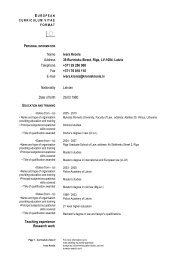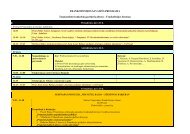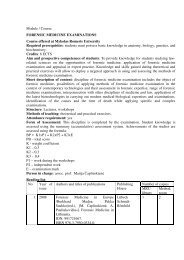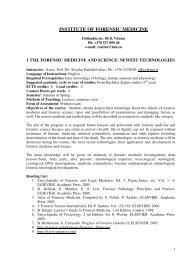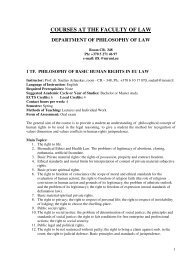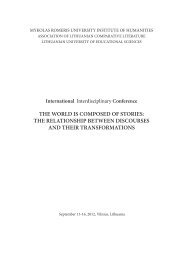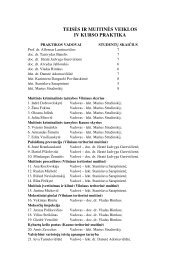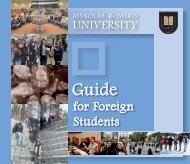SOCIAL MEDIA: CHALLENGES AND OPPORTUNITIES FOR ...
SOCIAL MEDIA: CHALLENGES AND OPPORTUNITIES FOR ...
SOCIAL MEDIA: CHALLENGES AND OPPORTUNITIES FOR ...
Create successful ePaper yourself
Turn your PDF publications into a flip-book with our unique Google optimized e-Paper software.
International interdisciplinary scientific conference /<br />
suteikiamos nau jos kartos aptarnavimo paslaugos, reikiama informacija suteikiama patogiu būdu, mokestinės<br />
procedūros gali būti atliekamos nuotoliniu savitarnos būdu. Kartu mažinamos mokesčių mokėtojų aptarnavimo<br />
išlaidos ir užtikrinama jų aptarnavimo kokybė.<br />
THE APPLICATION OF CROWDSOURCING IN EDUCATIONAL ACTIVITIES<br />
Monika Skaržauskaitė<br />
Mykolas Romeris University<br />
Ateities str. 20,<br />
LT-08303 Vilnius, Lithuania<br />
moskarzaus@stud.mruni.eu<br />
www.mruni.eu<br />
Purpose – This paper analyses the role of crowdsourcing use in educational activities. In recent decades, the<br />
rapid growth of innovative Internet based information and communication technologies created a new field of<br />
opportunities for organizations to reach their goals. One of the alternatives is - crowdsourcing. Crowdsourcing<br />
as defined by Jeff Howe (2006) is the act of taking a job traditionally performed by a designated employee<br />
and outsourcing it to an undefined, generally large group of people in the form of an open call. Educational<br />
organizations have many tasks that are essential, but that require time and energy that could be used to focus on<br />
instruction, crowdsourcing can be the answer.<br />
The newness of the term indicates that there is not any significant literature on the subject of how this<br />
operating method is utilized in educational activities. The objective of this paper therefore is to take an exploratory<br />
look at how educational organizations are using crowdsourcing as part of their activities at the present time, and<br />
to suggest how the practice of crowdsourcing may spread to other educational activities as time goes on.<br />
Design/Findings – The paper presents a theoretical model of crowdsourcing application in educational<br />
activities. The model is supported by the analysis and synthesis of the scientific literature and case studies.<br />
Research limitations/implications – The model presented here is a conceptual model and needs to be validated<br />
empirically.<br />
Practical implications – For practical purposes, the variables proposed in the model would provide a more<br />
comprehensive framework for the assessment of crowdsourcing use in education activities and work as a guide<br />
for crowdsourcing strategies<br />
Originality/value – Although the relevant literature consists of many partial and indirect insights and indications<br />
in the direction as conceived by the model, the full model as such is original. The authors’ primary contribution is<br />
in perceiving the holistic picture of the research subject.<br />
Keywords: crowdsourcing, social innovation, educational activities.<br />
TEACHERS <strong>AND</strong> STUDENTS COLLABORATION THROUGH THE E-MEDIUM:<br />
POSITIVE <strong>AND</strong> NEGATIVE ASPECTS OF ELECTRONIC COMMUNICATION<br />
Assoc. Prof. Dr. Agota Giedrė Raišienė<br />
Mykolas Romeris University<br />
Ateities str. 20,<br />
LT-08303 Vilnius, Lithuania<br />
agotar@mruni.eu<br />
www.mruni.eu<br />
Nowadays maintaining connections without the help of informational technologies is impossible to imagine.<br />
The electronic space of communication removes the necessity of coordinating the time, place and length of<br />
social contacts, and enables to expand the number of contacts at the moment. IT is undoubtedly progressive<br />
10



